
Theta Tauri is a wide double star in the constellation of Taurus and a member of the Hyades open cluster.

Upsilon Tauri is a solitary, white-hued star in the zodiac constellation of Taurus, and is a member of the Hyades star cluster. It is faintly visible to the naked eye with an apparent visual magnitude of +4.3. Based upon an annual parallax shift of 21.21 mas seen from Earth, it is around 154 light years from the Sun.

Rho Tauri is a star in the constellation Taurus and a member of the Hyades star cluster.

26 Arietis is a variable star in the northern constellation of Aries. 26 Arietis is the Flamsteed designation; it also bears the variable star designation UU Arietis. The apparent visual magnitude of this star is 6.14, which, according to the Bortle Dark-Sky Scale, is within the naked eye visibility limit in dark rural skies. The annual parallax shift of 13.78 mas is equivalent to a distance of approximately 215 light-years from Earth. The star is receding from the Earth with a heliocentric radial velocity of +15 km/s.

59 Aurigae, often abbreviated as 59 Aur, is a star in the constellation Auriga. Its baseline apparent magnitude is 6.1, meaning it can just barely be seen with the naked eye as a dim, yellow-white hued star. Based on parallax measurements, it is located about 483 light-years away from the Sun.

38 Cancri is a variable star in the zodiac constellation Cancer, located around 607 light years from the Sun. This object has the variable star designation BT Cancri; 38 Cancri is the Flamsteed designation. It is a member of the Praesepe cluster but is a challenge to view with the naked eye, having an apparent visual magnitude of 6.65. The star is moving closer to the Earth with a heliocentric radial velocity of +32 km/s.

Theta Cassiopeiae or θ Cassiopeiae is a solitary star in the northern constellation of Cassiopeia. It shares the traditional name Marfak with μ Cassiopeiae, positioned less than half a degree to the WSW, which is derived from the Arabic term Al Marfik or Al Mirfaq (المرفق), meaning "the elbow". At an apparent visual magnitude of 4.3, Theta Cassiopeiae is visible to the naked eye. Based upon an annual parallax shift of 24.42 mas, it is located about 134 light years from the Sun. It has a total annual proper motion of 0.227 arcseconds per year, and is slowly drifting further away from the Sun with a radial velocity of 2.5 km/s.
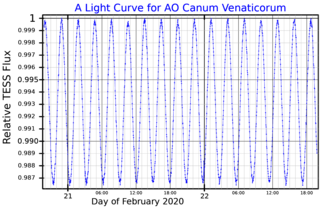
20 Canum Venaticorum is a single variable star in the northern constellation of Canes Venatici, located 238 light years from the Sun. This object has the variable star designation AO Canum Venaticorum; 20 Canum Venaticorum is the Flamsteed designation. It is visible to the naked eye as a faint, white-hued star with a baseline apparent visual magnitude of +4.72. The star is moving further from the Earth with a heliocentric radial velocity of +9 km/s. Eggen (1971) listed this star as a member of the Hyades Stream.

4 Canum Venaticorum is a binary star system in the northern constellation of Canes Venatici, located around 425 light years away. It has the variable star designation AI Canum Venaticorum; 4 Canum Venaticorum is its Flamsteed designation. Its brightness varies from magnitude +5.89 to +6.15 with a period of 2.8 hours, which places it around the lower limit of visibility to the naked eye. This was found to be a binary by Schmid et al. in 2014, based on periodic, non-sinusoidal changes in its radial velocity. It is a single-lined spectroscopic binary with an orbital period of 124.4 days and an eccentricity of 0.31.

71 Tauri is a suspected triple star system in the zodiac constellation Taurus, located 146 light years from the Sun. It is visible to the naked eye as a faint, yellow-white hued star with an apparent visual magnitude of +4.48. The star is moving further away from the Earth with a heliocentric radial velocity of +38 km/s. It is a member of the Hyades open cluster.

V352 Aurigae is a variable star in the northern constellation of Auriga. It dimly visible to the naked eye with an apparent visual magnitude that ranges from 6.13 down to 6.18. According to the Bortle scale, it is faintly visible to the naked eye from dark rural skies. The star is located at a distance of approximately 970 light years from the Sun based on parallax, but is drifting closer with a radial velocity of −7 km/s.

R Scuti is a star in the constellation of Scutum. It is a yellow supergiant and is a pulsating variable known as an RV Tauri variable. It was discovered in 1795 by Edward Pigott at a time when only a few variable stars were known to exist.
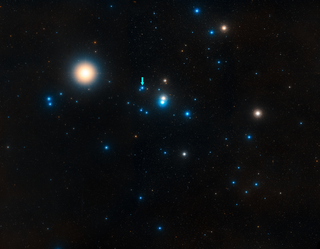
HD 28527 is a star in the constellation Taurus, and a member of the Hyades open cluster. It is faintly visible to the naked eye with an apparent visual magnitude of 4.78. The distance to this star, as determined from its parallax shift of 22 mas, is 148 light years. It is moving away from the Earth with a heliocentric radial velocity of +38 km/s.

Rho Phoenicis is a variable star in the constellation of Phoenix. From parallax measurements by the Gaia spacecraft, it is located at a distance of 245 light-years from Earth.
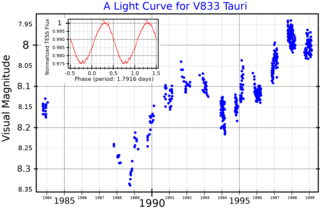
HD 283750, also known as V833 Tauri, is a K-type main-sequence star 57 light-years away from the Sun. The star is much younger than the Sun's at 1 billion years. HD 283750 is similar to the Sun in its concentration of heavy elements.

SZ Tauri is a variable star in the equatorial constellation of Taurus. The brightness of this star varies from an apparent visual magnitude of 6.39 down to 6.69 with a period of 3.149 days, which is near the lower limit of visibility to the naked eye. The distance to this star is approximately 2,070 light years based on parallax measurements. There is some indication this may be a binary system, but the evidence is inconclusive.

FG Virginis is a well-studied variable star in the equatorial constellation of Virgo. It is a dim star, near the lower limit of visibility to the naked eye, with an apparent visual magnitude that ranges from 6.53 down to 6.58. The star is located at a distance of 273.5 light years from the Sun based on parallax measurements, and is drifting further away with a radial velocity of +16 km/s. Because of its position near the ecliptic, it is subject to lunar occultations.
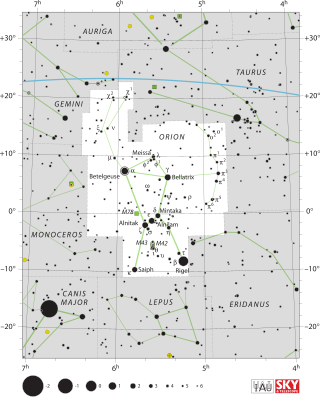
HD 40372, also known as 59 Orionis, V1004 Orionis and HR 2100, is a variable star in the constellation Orion. Its apparent magnitude varies between magnitude 5.88 and 5.92, making it faintly visible to the naked eye for an observer far from light polluted urban areas. HD 40372 exhibits two types of variability; it is an eclipsing binary star and one of the two stars is a Delta Scuti variable star.

79 Tauri, also known as b Tauri, is an Am star in the constellation of Taurus with an apparent magnitude of 5.0. It is a member of the Hyades open cluster and parallax measurements by Gaia give a distance of about 157 light years.
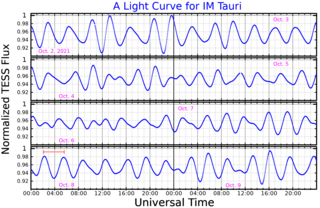
44 Tauri, also known as HD 1287 and IM Tauri, is a star located about 210 light years from the Earth, in the constellation Taurus. It is a 5th magnitude star, making it faintly visible to the naked eye of an observer located far from city lights. It is a Delta Scuti variable star, ranging between magnitude 5.37 and 5.58 over a period of about 3.5 hours.



















